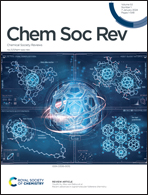Reactivity of metal–oxo clusters towards biomolecules: from discrete polyoxometalates to metal–organic frameworks
Abstract
Metal–oxo clusters hold great potential in several fields such as catalysis, materials science, energy storage, medicine, and biotechnology. These nanoclusters of transition metals with oxygen-based ligands have also shown promising reactivity towards several classes of biomolecules, including proteins, nucleic acids, nucleotides, sugars, and lipids. This reactivity can be leveraged to address some of the most pressing challenges we face today, from fighting various diseases, such as cancer and viral infections, to the development of sustainable and environmentally friendly energy sources. For instance, metal–oxo clusters and related materials have been shown to be effective catalysts for biomass conversion into renewable fuels and platform chemicals. Furthermore, their reactivity towards biomolecules has also attracted interest in the development of inorganic drugs and bioanalytical tools. Additionally, the structural versatility of metal–oxo clusters allows for the efficiency and selectivity of the biomolecular reactions they promote to be readily tuned, thereby providing a pathway towards reaction optimization. The properties of the catalyst can also be improved through incorporation into solid supports or by linking metal–oxo clusters together to form Metal–Organic Frameworks (MOFs), which have been demonstrated to be powerful heterogeneous catalysts. Therefore, this review aims to provide a comprehensive and critical analysis of the state of the art on biomolecular transformations promoted by metal–oxo clusters and their applications, with a particular focus on structure–activity relationships.



 Please wait while we load your content...
Please wait while we load your content...